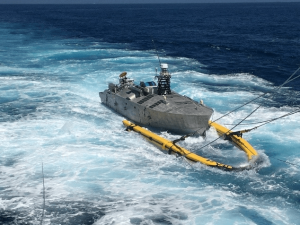After completing formal testing, the US Office of the Chief of Naval Operations has assigned its first Unmanned Influence Sweep System (UISS) minesweeper Initial Operating Capability (IOC).
In an effort to not only remove the risk of harm to humans but at the same time cut back on spending, the US Navy said the crewless ship has the ability to be operated from littoral combat ships (LCS), shore, or vessels of opportunity (VOO).

Unmanned Influence Sweep System (UISS) minesweeper
The ship will be used for acoustic, magnetic minesweeping and mine hunting missions, in action with its Mine Countermeasures Unmanned Surface Vehicle (MCM USV), the semi-autonomous, diesel-powered, aluminium-hulled vehicle.
This marks the Navy’s debut into robotics, signaling an “important milestone” in its mission towards a hybrid fleet of manned and unmanned systems, according to the Navy, and although the programme is still very much in its infancy, the declaration that the UISS is ready for deployment shows “the programme is inching closer toward system-wide IOC for the MCM MP (Mission Package),” said Captain Godfrey “Gus” Weekes, LCS Mission Modules programme manager.
“UISS’s declaration of IOC is a monumental achievement for the Navy’s Mine Countermeasures (MCM) MP,” he added. “Over the years, the programme has worked tirelessly to mature and field the UISS system that will keep the Navy’s most valuable asset, our sailors, safer by keeping them out of the minefield.”
The news follows others in the sector advances in robotics, such as IBM’s self-steering ship Mayflower completing its transatlantic venture to North America. And with the robotics industry set to hit $4.9bn by 2031, it can be expected to see more businesses shifting to autonomous ways of operation.